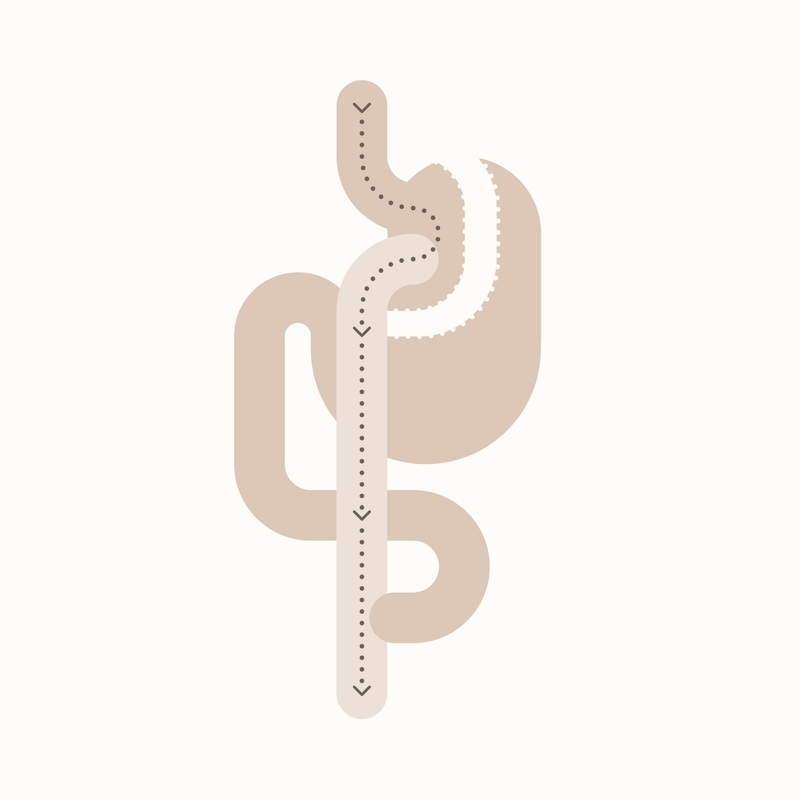If you’d like to discuss Roux-en-Y, one anastomosis gastric bypass or other surgical and non-surgical weight loss options, contact us anytime to schedule an appointment with a member of the team.
WHAT IS A ROUX-EN-Y GASTRIC BYPASS?
Roux-en-Y gastric bypass is a type of weight-loss surgery that involves creating a small pouch from the stomach and connecting the newly created pouch directly to the small intestine. Another join is then created between the small bowel, to ensure drainage of bile as well.
After Roux-en-Y surgery, swallowed food will go into this small pouch of stomach and then directly into the small intestine, thereby bypassing most of your stomach and the first section of your small intestine type. This is compared to the ‘one anastomosis gastric bypass’ where there is only one join between the stomach and the small bowel.
Roux-en-Y gastric bypass is the oldest form of bariatric surgery and was the gold standard for many years. Now that newer techniques have evolved, Dr Balalis most often uses Roux-en-Y for reflux or revision surgery.
WHO IS ELIGIBLE FOR ROUX-EN-Y GASTRIC BYPASS?
Guidelines for gastric bypass include:
- Age >18
- BMI 30 with weight related comorbidities
- Or BMI ≥ 35 with no comorbidities needed
- No eating disorders
- No untreated acute psychiatric disorders
- No alcohol or drug dependency
- Has tried other avenues without success
- Committed to a healthy lifestyle and lifelong care
Note: these are guidelines, and all patients require a discussion regarding one anastomosis gastric bypass and other forms of bariatric surgery.
HOW DOES THE ROUX-EN-Y GASTRIC BYPASS WORK?
The Roux-en-y works by both decreasing the volume of the gastric pouch, as well as providing hormonal changes by bypassing the duodenum and part of the jejunum. This results in a decrease in levels of hunger, as well as a feeling of fullness with a smaller amount of food. There are also changes to absorption by bypassing over 150cms of your small bowel.
HOW MUCH WEIGHT CAN I EXPECT TO LOSE?
Patients can expect to lose around 65-75% of excess weight, with the majority occurring in the first year.
WHAT DOES THIS MEAN?
For an example, a 176cm patient who weighs 140kgs, has a BMI of 45. Their ideal weight is 78kgs (for a BMI 25), which means an excess weight of 62kgs. This means that 70% of this is 43kgs, and this patient can expect to end up at around 97kgs as a rough guide.
WHAT ARE SOME OF THE POTENTIAL HEALTH BENEFITS?
Roux-en-y is also effective at normalising diabetes, blood pressure, high cholesterol and sleep apnoea to name a few. Trials have shown that in patients with type 2 diabetes, at 3 years over 60% have normal blood sugars.
WHAT ARE THE RISKS?
Chronic complications include but are not limited to strictures, internal hernias, gastro-gastric fistulae, gallstones, marginal ulcers, dumping syndrome, and the nutritional deficiencies that accompany altering the GI tract. The Roux-en-Y gastric bypass also has a risk of internal hernias that is far higher than a OAGB (one anastomosis gastric bypass). If a patient has abdominal pain, even many years following a Roux-en-Y gastric bypass, it is important to seek medical attention as an internal hernia can be a serious complication.
Patients require regular nutritional monitoring following their Roux-en-Y gastric bypass and need to continue a multivitamin long-term.
As with all weight loss surgeries performed, it is important to continue to work with your multidisciplinary team towards long-lasting good habits and routines.
HOW MUCH WEIGHT CAN I EXPECT TO LOSE?
Patients can expect to lose around 65-75% of excess weight, with the majority occurring in the first year.
